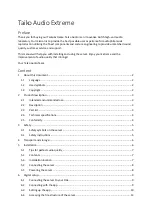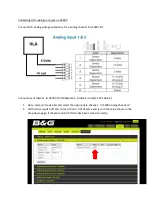
Chapter 3 - PBpro ETH Adm inistration
PBpro ETH - User Guide
19
The host name of the device can be set individually. By default it is built from PBpro ETH's
part number and serial number that can be found on the device's type label, e.g. DEA-NN-
012311-123200003.
If
Use DHCP
is activated, the IP settings are not accessible for configuration. In this case
the PBpro ETH when rebooted is assigned appropriate settings by the network's DHCP
server. To find out these new settings PBpro ETH may then be accessed by any web
browser using its host name or a
[New search]
is conducted using
Search and
Configure
.
Changing the IP configuration requires the password fitting the selected device. The
default password is "config". It can only be changed via PBpro ETH's web interface.
3.3.3
IP Basics
Following a short introduction to the Internet Protocol (IP) which can be useful in
integrating the PBpro ETH in your Local Area Network (LAN). If you are already familiar
with the basics of the Internet Protocol, you may skip this section.
IP (Internet Protocol)
The Internet Protocol makes it possible to combine an undefined number of separate
networks to an overall network, allowing data exchange between any two network stations
in any two subnetworks. The physical characteristics of the networks or of the
transmission paths (Ethernet, Token Ring, ISDN, ...) are of no importance. The data will
be transferred to the receiver independently of these differences.
IP addresses
Under IP, every network station has a unique Internet address, often called "IP number".
This Internet address is a 32-bit value which is written, for better readability, in the form of
four decimal numbers (8-bit values) separated by dots (dot notation), e.g. 192.168.1.5. In
the future, 128-bit addresses will be used.
The Internet address consists of net ID and host ID, where the net ID is used to identify the
network and the host ID to identify the station within a network.
The network class defines, which part of the IP address belongs to the net ID and which
one to the host ID. For the addressing of normal networks, three network classes exist:
Class A, Class B and Class C:
Address range of the
network
Possible number of
networks
Possible number of
hosts per network
Class A
1.xxx.xxx.xx to
126.xxx.xxx.xxx
127 (27)
Approx. 16 million (224)
Class B
128.0.xxx.xxx to
191.255.xxx.xxx
Approx. 16000 (214)
Approx. 65000 (216)
Class C
192.0.0.xxx to
223.255.255.xxx
Approx. 2 million (221)
254 (28)
Table 3: Key data of the different network classes
















































